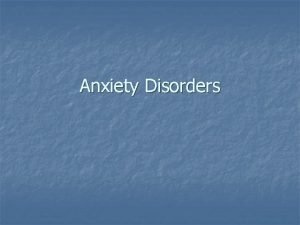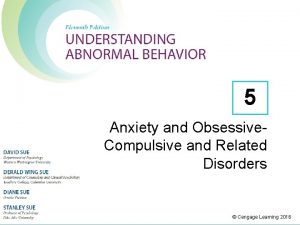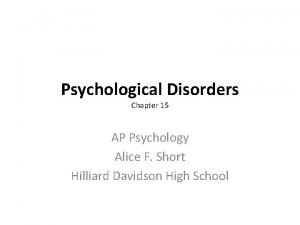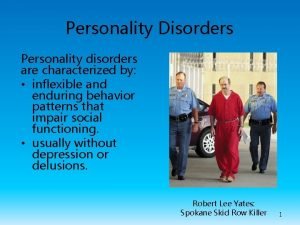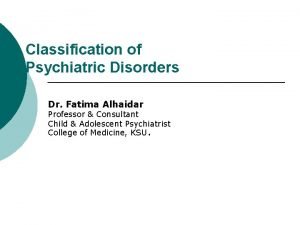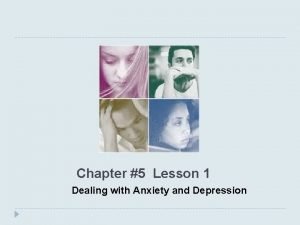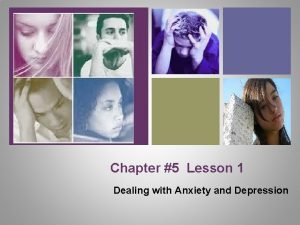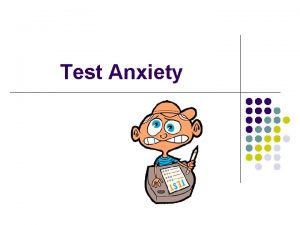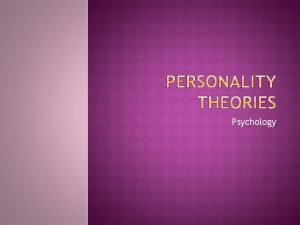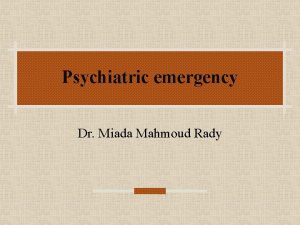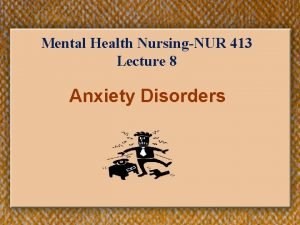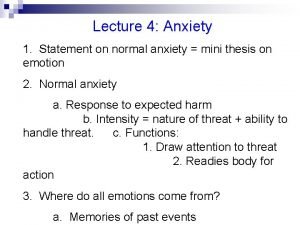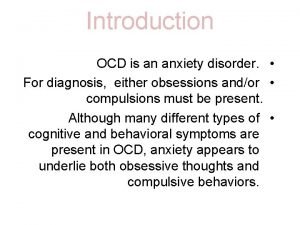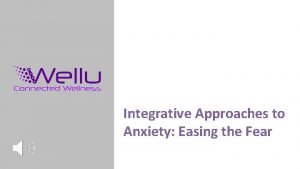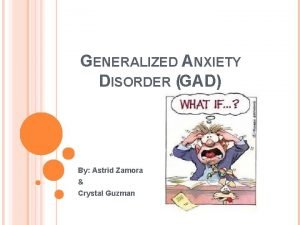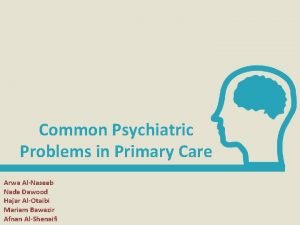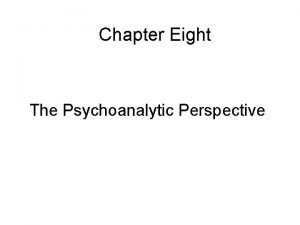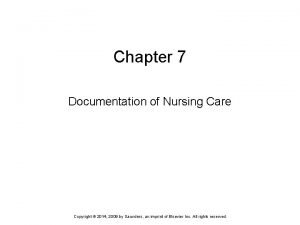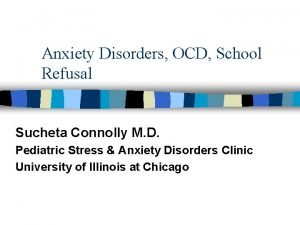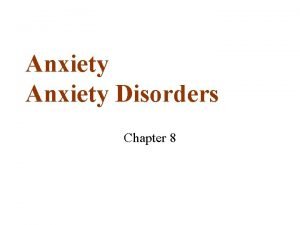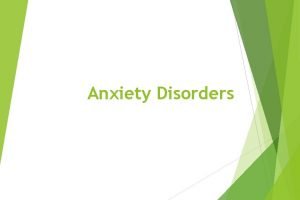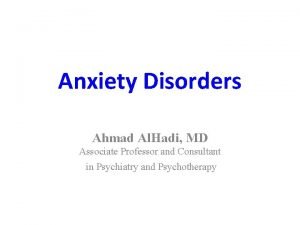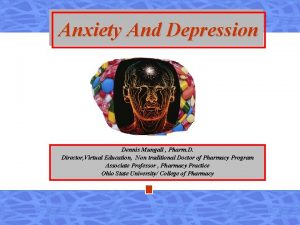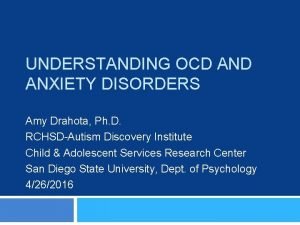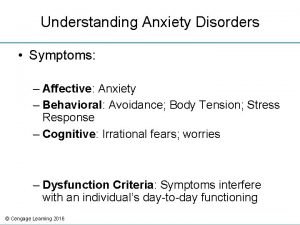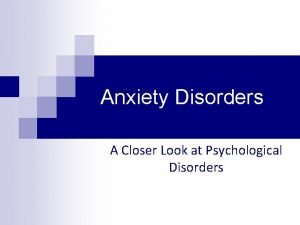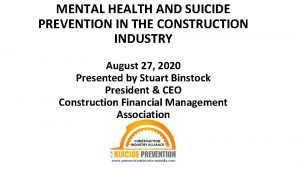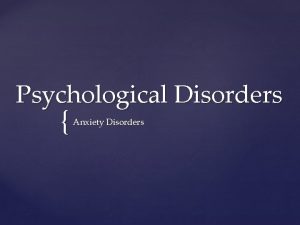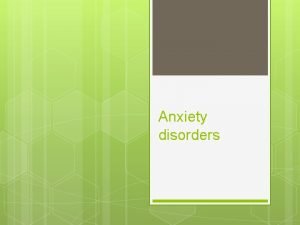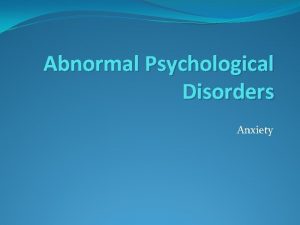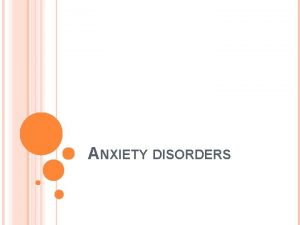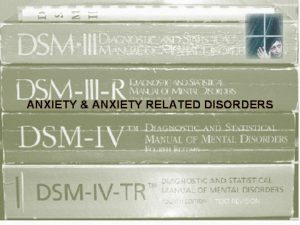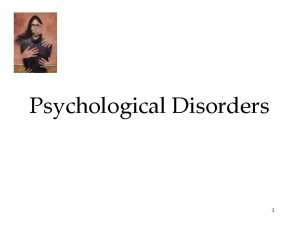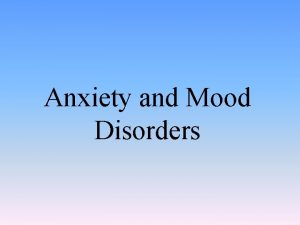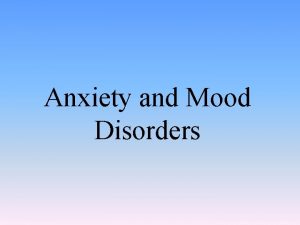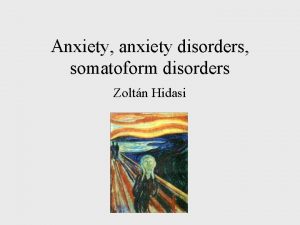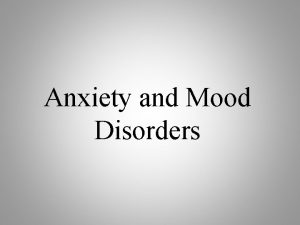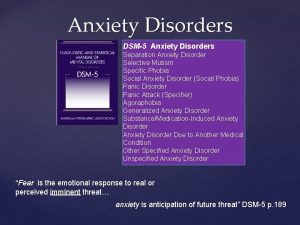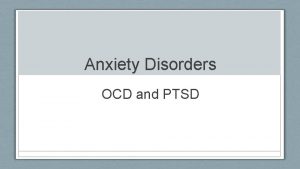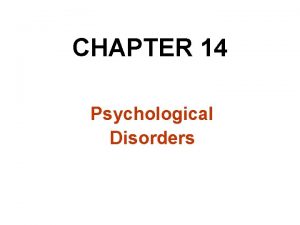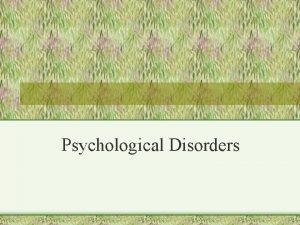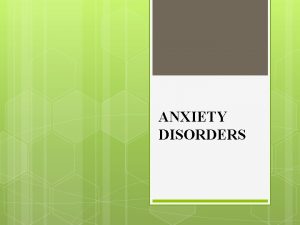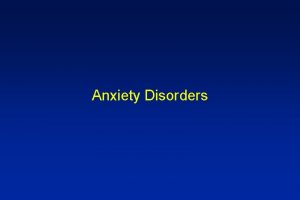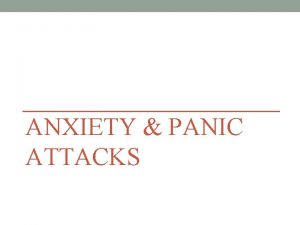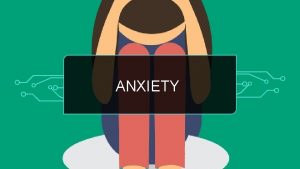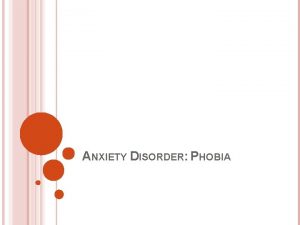CHAPTER 12 Psychological Disorders Studying Psychological Disorders Anxiety





















































- Slides: 53

CHAPTER 12 Psychological Disorders • • • Studying Psychological Disorders Anxiety Disorders Depressive and Bipolar Disorders Schizophrenia Other Disorders Gender and Cultural Effects © 2016 John Wiley & Sons, Inc. All rights reserved.

Real World Psychology Things you’ll learn in Chapter 12 Q 1 How can media coverage of mass shootings create negative misperceptions about people with mental illness? Q 2 What is the most “contagious” psychological disorder? Q 3 Can Internet and cell phone use increase mental health problems? Q 4 Are children who experience trauma at increased risk of developing schizophrenia later in life? Q 5 Q 6 How do changes in the brain help explain severe antisocial personality disorder? Are symptoms of depression in women more distressing, deserving of sympathy and difficult to treat than the same © 2016 John Wiley & Sons, Inc. All rights signs in men? reserved.

Studying Psychological Disorders Identifying & Explaining Psychological Disorders • Abnormal behavior – aka psychopathology – Patterns of behavior, thoughts or emotions considered pathological (diseased or disordered) – Regarded as such for one or more of four reasons • • Deviance Dysfunction Distress Danger © 2016 John Wiley & Sons, Inc. All rights reserved.

Studying Psychological Disorders Identifying & Explaining Psychological Disorders (continued) Four criteria for identifying abnormal behavior 1. Deviance Behaviors, thoughts or emotions may be considered abnormal when they deviate from a society or culture’s norms or values. For example, it’s normal to be a bit concerned if friends are whispering, but abnormal if you’re equally concerned when total strangers are whispering. © 2016 John Wiley & Sons, Inc. All rights reserved. FIGURE 12. 1 a

Studying Psychological Disorders Identifying & Explaining Psychological Disorders (continued) Four criteria for identifying abnormal behavior (continued) 2. Dysfunction When someone’s dysfunction interferes with his or her daily functioning, such as drinking to the point that it interferes with holding a job, staying in school or maintaining a relationship, it would be considered abnormal behavior. © 2016 John Wiley & Sons, Inc. All rights reserved. FIGURE 12. 1 b

Studying Psychological Disorders Identifying & Explaining Psychological Disorders (continued) Four criteria for identifying abnormal behavior (continued) 3. Distress Behaviors, thoughts or emotions that cause significant personal distress may quality as abnormal. Self-abuse, serious relationship problems and suicidal thoughts all indicate significant personal distress and unhappiness. FIGURE 12. 1 c © 2016 John Wiley & Sons, Inc. All rights reserved.

Studying Psychological Disorders Identifying & Explaining Psychological Disorders (continued) Four criteria for identifying abnormal behavior (continued) 4. Danger If someone’s thoughts, emotions or behaviors present a danger to self or others, such as engaging in road rage to the point of physical confrontation, it would be considered abnormal. FIGURE 12. 1 d © 2016 John Wiley & Sons, Inc. All rights reserved.

Studying Psychological Disorders Identifying & Explaining Psychological Disorders (continued) • Causes of and treatments for abnormal behavior: a historical look – Stone Age: demon possession • Hole drilled in skull to release evil spirits – Middle Ages: demon possession • An exorcism may have been conducted • Asylums were built – Renaissance: witchcraft • Ill may have been tortured, killed © 2016 John Wiley & Sons, Inc. All rights reserved. imprisoned or FIGURE 12. 2

Studying Psychological Disorders Identifying & Explaining Psychological Disorders (continued) • Causes of and treatments for abnormal behavior: the beginnings of the modern era – The medical model (Philippe Pinel) • Assumes mental illnesses have physical causes that can be diagnosed, treated and perhaps cured – Led to the foundation for psychiatry • In contrast, psychology focuses on social and cultural factors that contribute to psychological disorders © 2016 John Wiley & Sons, Inc. All rights reserved.

Studying Psychological Disorders Identifying & Explaining Psychological Disorders (continued) Common Myths About Mental Illness MYTH: Mentally ill people are often dangerous and unpredictable FACT: Only a few disorders are associated with violence MYH: People with psychiatric disorders act in bizarre ways and are very different from normal people FACT: This is true for only a small minority of individuals and during relatively brief periods of their lives MYTH: Psychological disorders are a sign of personal weakness FACT: Like all illnesses, psychological disorders are a function of many factors (e. g. we don’t blame the patient for contracting cancer [!]) MYTH: A mentally ill person is only suited for low-level jobs and never fully recovers FACT: Like all illnesses, psychological disorders are complex, and their symptoms, severity and prognoses differ for each individual TABLE 12. 1 © 2016 John Wiley & Sons, Inc. All rights reserved.

Studying Psychological Disorders Identifying & Explaining Psychological Disorders (continued) Seven psychological perspectives FIGURE 12. 3 Note that, while these seven major perspectives differ in their explanations for the general causes of psychological disorders, there still is considerable overlap between them © 2016 John Wiley & Sons, Inc. All rights reserved.

Studying Psychological Disorders Classifying Psychological Disorders • The Diagnostic and Statistical Manual of Mental Disorders (DSM) – Identifies and explains abnormal behavior – Classifies abnormal behavior into categories – Latest (5 th) edition was published in 2013 • Clarifying terms – Neurosis – Psychosis – Insanity (legal, not clinical, term) © 2016 John Wiley & Sons, Inc. All rights reserved.

Studying Psychological Disorders Classifying Psychological Disorders (continued) Using an Insanity Plea as a Legal Defense • Used in fewer than 1% of all cases that reach trial • Used successfully in only a fraction of those trials - These cases often receive a lot of publicity FIGURE 12. 4 © 2016 John Wiley & Sons, Inc. All rights reserved.

Studying Psychological Disorders Understanding the DSM • Identifies and describes the symptoms of approximately 400 different disorders • These are grouped into 22 categories • Comorbidity – Co-occurrence of two or more disorders in the same person at the same time (e. g. depression and alcoholism) © 2016 John Wiley & Sons, Inc. All rights reserved.

Studying Psychological Disorders Evaluating the DSM • Essential benefits – Identifying and diagnosing disorders – Predicting future outcomes – Suggesting appropriate treatment • Criticisms – ‘Casting a wide net’ (over-diagnosing) – Potentially culturally biased (reflecting Western European and U. S. perspective) – Possibly overly reliant on the medical model (may unfairly label people) © 2016 John Wiley & Sons, Inc. All rights reserved.

Q 1 How can media coverage of mass shootings create negative misperceptions about people with mental illness? • 450 million people worldwide have a mental illness (i. e. it is widespread and not rare) • Often mentioned: mental illness was a motivating factor and a common thread in mass shootings (Gonyea & Montanaro, 2015; Lysiak, 2015) • Rarely if ever mentioned: people with mental illness are more often self-destructive or the victims of (rather than the perpetrators of) violence (Mc. Ginty et al, 2013; Metzl & Mac. Leish, 2015) © 2016 John Wiley & Sons, Inc. All rights reserved.

Anxiety Disorders Describing Anxiety Disorders • Occur when the experiences and symptoms of fear and anxiety become disabling – Uncontrollable and disruptive – Physiological arousal and behavioral disturbances • Three main types – Generalized anxiety disorder – Panic disorder – Phobias © 2016 John Wiley & Sons, Inc. All rights reserved. NBA player Royce White has been very open about his intense fear of flying, hoping to boost public aware ness of psychological illness.

Anxiety Disorders Describing Anxiety Disorders (continued) FIGURE 12. 5 © 2016 John Wiley & Sons, Inc. All rights reserved.

Anxiety Disorders Explaining Anxiety Disorders • Psychological factors – Faulty cognitive processes – Maladaptive learning (e. g. faulty / improper conditioning) • Biological factors – Evolutionary predisposition – Genetic predispositions – Biochemical disturbances • Sociocultural factors – Exposure to abuse – Pace and stress of life in the U. S. © 2016 John Wiley & Sons, Inc. All rights reserved.

Anxiety Disorders Explaining Anxiety Disorders (continued) Anxiety disorders & the psychosocial model FIGURE 12. 6 © 2016 John Wiley & Sons, Inc. All rights reserved.

Anxiety Disorders Explaining Anxiety Disorders (continued) Conditioning and Phobias Step 1 – Classical Conditioning Little Albert learned to fear white rats © 2016 John Wiley & Sons, Inc. All rights reserved. PROCESS DIAGRAM 12. 1 a

Anxiety Disorders Explaining Anxiety Disorders (continued) Conditioning and Phobias (continued) Step 2 – Operant Conditioning Little Albert might have later learned to avoid rats through operant conditioning, thereby reducing his fear, giving unintended reinforcement to his fearful behavior. PROCESS DIAGRAM 12. 1 b © 2016 John Wiley & Sons, Inc. All rights reserved.

Anxiety Disorders Explaining Anxiety Disorders (continued) Conditioning and Phobias (continued) Step 3 – Phobia Over time, a cycle of fear and avoidance could lead to an intense, irrational fear, known as phobia. PROCESS DIAGRAM 12. 1 c © 2016 John Wiley & Sons, Inc. All rights reserved.

Q 2 What is the most contagious psychological disorder? • Anxiety disorders may develop from modeling and imitation – Hence, this type of social learning makes anxiety disorders the most “contagious” of all psychological disorders as children “catch” it primarily by watching and modeling their anxious parents’ behaviors (Dean, 2015) © 2016 John Wiley & Sons, Inc. All rights reserved.

Depressive and Bipolar Disorders Describing Depressive and Bipolar Disorders • Characterized by sad, empty or irritable moods that interfere with functioning • Symptoms – Difficulty sleeping – Weight gain or loss – Fatigue – Problems concentrating – Profound sadness, guilt or suicidal thoughts • May be unipolar or bipolar © 2016 John Wiley & Sons, Inc. All rights reserved.

Depressive and Bipolar Disorders Describing Depressive and Bipolar Disorders (continued) • Unipolar – When the depressive period ends, the person generally returns to a normal emotional level • Bipolar – The person cycles between periods of a depressed state and a manic state • Unreasonable elation with hyperactivity • May include aggression and/or impulsivity • Period may span from a few days to a few months, ending abruptly – Low lifetime risk but most debilitating/lethal © 2016 John Wiley & Sons, Inc. All rights reserved.

Depressive and Bipolar Disorders Describing Depressive and Bipolar Disorders (continued) With bipolar disorder, the sufferer cycles through periods of a clinically depressed state and an elated (manic) state. With major depressive disorder, the sufferer returns to a normal psychological state after a period of being clinically depressed ends. FIGURE 12. 7 © 2016 John Wiley & Sons, Inc. All rights reserved.

Depressive and Bipolar Disorders Explaining Depressive and Bipolar Disorders • Biological Factors – Brain damage from repeated concussions – Imbalance of neurotransmitters – Diet high in fast food and/or commercially FIGURE produced baked goods 12. 8 • Psychosocial Factors – Anger turned inward (psychoanalytic) – Negative thinking patterns (cognitive) – Obsession over problems (humanistic) – Learned helplessness © 2016 John Wiley & Sons, Inc. All rights reserved.

Q 3 Can internet and cell phone use increase mental health problems? • Surprisingly, high internet and cell phone use are linked with mental health problems such as depression and anxiety (Panova & Lleras, 2016) - This is particularly true when the internet and cell phone is used to avoid negative experiences or feelings - No link was found when these were used merely to escape boredom © 2016 John Wiley & Sons, Inc. All rights reserved.

Depressive and Bipolar Disorders Explaining Depressive and Bipolar Disorders (continued) Common Myths About Suicide 1. People who talk about suicide are less likely to actually complete it. 2. Suicide usually takes place with little or no warning. 3. Suicidal people are fully intent on dying. 4. Children of parents who attempt suicide are at greater risk of dying by suicide. 5. Suicidal people remain so forever. TABLE 12. 3 6. Although men are much more likely to attempt suicide, women are far more likely to actually complete it. 7. When a suicidal person has been severely depressed, and seems to be ‘snapping out of it, ’ the danger of suicide decreases substantially. 8. Only depressed people die by suicide. 9. Thinking about suicide is rare. 10. Asking a depressed person about suicide will push him or her ‘over the edge’ and cause a suicidal act that might not have otherwise have occurred. © 2016 John Wiley & Sons, Inc. All rights reserved.

Schizophrenia Symptoms of Schizophrenia Major disturbances in one or more of the following: • Perception – May experience hallucinations • Language and Thought – Words are bizarre or have strange meanings – Logic is impaired (delusions are common) • Emotion (exaggerated or blunted) • Behavior (peculiar movements or social withdrawal) © 2016 John Wiley & Sons, Inc. All rights reserved.

Schizophrenia Classifying Schizophrenia Formerly 5 categories, replaced by: 1. Positive schizophrenia symptoms – Additions or exaggerations to normal functioning (e. g. delusions, hallucinations) 2. Negative schizophrenia symptoms – Loss or absence of normal functions (e. g. impaired attention, limited or toneless speech, flat or blunted affect, social withdrawal) © 2016 John Wiley & Sons, Inc. All rights reserved.

Schizophrenia Explaining Schizophrenia • Biological Factors – Genetics • Risk for acquiring increases when family member has the disorder a – Neurotransmitters • Overactivity in certain dopamine neurons – Brain abnormalities • Larger fluid-filled spaces in the brain • Lower activity levels in the frontal lobe © 2016 John Wiley & Sons, Inc. All rights reserved.

Schizophrenia Explaining Schizophrenia (continued) Figure 12. 9 in the text shows the that the lifetime risk of developing schizophrenia is strongly linked to one’s genetic inheritance Does this represent a positive or a negative correlation? FIGURE 12. 9 © 2016 John Wiley & Sons, Inc. All rights reserved.

Schizophrenia Explaining Schizophrenia (continued) • Prenatal and Other Environmental Factors – Prenatal stress and viral infections – Birth complications or low birth weight – Immune system responses – Maternal malnutrition – Advanced maternal age – Diathesis-stress model • A predisposition, triggered when exposed to certain extremely stressful life experiences © 2016 John Wiley & Sons, Inc. All rights reserved.

Q 4 Are children who experience trauma at increased risk of developing schizophrenia later in life? • Yes. Children who experience trauma before age 16 are three times more likely than other people to develop schizophrenia. (Bentall et al. , 2012; De. Rosse et al. , 2014) • People who experience stressful living environments – including poverty, unemployment and crowding – are also at increased risk. (Brown & Lau, 2016; Kirkbridge et al. , 2014; Sweeney et al. , 2015) © 2016 John Wiley & Sons, Inc. All rights reserved.

Schizophrenia Explaining Schizophrenia (continued) FIGURE 12. 11 © 2016 John Wiley & Sons, Inc. All rights reserved.

Other Disorders Obsessive-Compulsive Disorder (OCD) • Characterized by one or both of these: – Persistent, unwanted, fearful thoughts (obsessions) • e. g. , fear of germs – Irresistible urges to perform repetitive and/or ritualized behaviors (compulsions) • e. g. , persistent / repetitive cleaning and/or handwashing to eliminate germs The purpose of the compulsions (behaviors) is to help relieve the anxiety created by the obsessions (thoughts) © 2016 John Wiley & Sons, Inc. All rights reserved.

Other Disorders Obsessive-Compulsive Disorder (continued) Managing OCD A few celebrities who suffer from OCD - Megan Fox (actress, pictured) David Beckham (soccer star) Leonardo Di. Caprio Justin Timberlake (singer / actor) Through therapy and medication, people can learn to manage the symptoms of OCD and can lead highly FIGURE productive and fulfilling lives. © 2016 John Wiley & Sons, Inc. All rights reserved. 12. 12

Other Disorders Dissociative Disorders • Marked by a sudden break (dissociation) in conscious awareness, self-identify and/or memory • Dissociative identity disorder (DID) – Characterized by the presence of two or more distinct personality systems (or identities) in the FIGUR same individual E – Previously known as multiple personality 12. 14 disorder (MPD) – Diagnosis is highly controversial © 2016 John Wiley & Sons, Inc. All rights reserved.

Other Disorders Dissociative Disorders (continued) Dissociation as an Escape Can you see how your mind might cope by blocking out all memory of such an event? FIGURE 12. 13 A common factor in dissociative disorders is the need to escape and cope with extreme stress. Imagine witnessing a loved one’s death in a horrible car accident. © 2016 John Wiley & Sons, Inc. All rights reserved.

Other Disorders Personality Disorders • Characterized by chronic, inflexible, maladaptive personality traits – These cause significant impairment of social and occupational functioning • Major types – Antisocial Personality Disorder (ASPD) – Borderline Personality Disorder (BPD) © 2016 John Wiley & Sons, Inc. All rights reserved.

Other Disorders Personality Disorders (continued) Antisocial Personality Disorder (ASPD) • Characteristics – Egocentrism – A lack of conscience, remorse or empathy • Causes – Biological • Possible genetic predisposition/brain activity – Environmental/psychological • Abusive parenting, emotional deprivation, harsh/inconsistent discipline, residential mobility and antisocial parental behavior © 2016 John Wiley & Sons, Inc. All rights reserved.

Q 5 How do changes in the brain help explain severe antisocial personality disorder? • MRI brain scans of criminals still in prison for violent crimes, such as rape, murder or attempted murder, and showing little empathy and remorse for their crimes, reveal reduced gray matter volume in the prefrontal cortex. (Gregory et al. , 2012) You may recall that this area of the brain is responsible for emotions, such as fear, empathy and/or guilt. © 2016 John Wiley & Sons, Inc. All rights reserved.

Other Disorders Personality Disorders (continued) Borderline Personality Disorder (BPD) • Characteristics – Severe instability in emotions, relationships and self-image – Impulsive and self-destructive behaviors • Causes – An interaction of biopsychosocial factors • • Childhood neglect or emotional deprivation Physical, sexual or emotional abuse Impaired functioning of the frontal lobes and limbic system Slight genetic predisposition © 2016 John Wiley & Sons, Inc. All rights reserved.

Gender and Cultural Effects Gender Differences • Women experience depression at twice the rate of men, around the world • Reasons: – Higher incidence of poverty in women – Women experience more sexual trauma, partner abuse and chronic stress – Women tend to ruminate more frequently • This internalizes – rather than resolves – negative emotions – Men tend to hide and/or redirect emotions that are stereotypically feminine (e. g. crying) © 2016 John Wiley & Sons, Inc. All rights reserved.

Q 6 Are symptoms of depression in women more distressing, deserving of sympathy and difficult to treat than the same signs in men? • One study asked participants to read a story about a fictitious person who was struggling with various stressful and depressing situations. - Two versions of the story were created: one using the name Kate and the other using the name Jack. Otherwise, the stories were identical. • Those who read the story about Kate rated her symptoms as more distressing, deserving of sympathy and difficult to treat. (Swami et al. , 2012) © 2016 John Wiley & Sons, Inc. All rights reserved.

Gender and Cultural Effects Culture & Psychological Disorders • Schizophrenia – Rates and symptoms differ across cultures • Unsure if rates may be tied to the disorder’s prevalence or differences in definition, diagnosis or reporting – Prognosis in industrialized nations is worse. Reasons: • Core symptoms make it harder to survive in industrialized nations • Reduced social support and responsibility among family and friends in industrialized nations © 2016 John Wiley & Sons, Inc. All rights reserved.

Gender and Cultural Effects Culture & Psychological Disorders (continued) What is stressful? FIGURE 12. 15 a / AND 12. 15 b / a) Some stressors are culturally specific, such as feeling possessed by evil forces or being the victim of witchcraft. b) Other stressors are shared by many cultures, such as the unexpected death of a loved one or the loss of a job. © 2016 John Wiley & Sons, Inc. All rights reserved.

Gender and Cultural Effects Culture & Psychological Disorders (continued) Culture-General Symptoms of Mental Health Difficulties Nervous Trouble sleeping Low spirits Weak all over Personal worries Restless Feel apart, alone Can’t get along Hot all over Worry all the time Can’t do anything worthwhile TABLE 12. 4 Nothing turns out right © 2016 John Wiley & Sons, Inc. All rights reserved.

Gender and Cultural Effects Avoiding Ethnocentrism • Most research on disorders is conducted in Western cultures – This can limit understanding of disorders • Culture-general vs. culture-bound symptoms – Cultural-general – appear across cultures – Culture-bound – appear only in select cultures • Cultures may have different names and understanding of similar experiences • Existence of culture-bound disorders © 2016 John Wiley & Sons, Inc. All rights reserved.

Gender and Cultural Effects Avoiding Ethnocentrism Culture-bound disorders TABLE 12. 16 Some disorders are fading as remote areas become more Westernized, whereas other disorders (such as anorexia nervosa) are spreading as other countries adopt Western values. © 2016 John Wiley & Sons, Inc. All rights reserved.

© 2016 John Wiley & Sons, Inc. All rights reserved.
 Chapter 15 anxiety and obsessive-compulsive disorders
Chapter 15 anxiety and obsessive-compulsive disorders Anxiety disorders def
Anxiety disorders def Gangguan cemas icd 10
Gangguan cemas icd 10 Multipath model of anxiety disorders
Multipath model of anxiety disorders Chapter 18 psychological disorders
Chapter 18 psychological disorders Chapter 18 psychological disorders
Chapter 18 psychological disorders Chapter 14 psychological disorders
Chapter 14 psychological disorders Chapter 14 psychological disorders
Chapter 14 psychological disorders Ap psychology chapter 15 psychological disorders
Ap psychology chapter 15 psychological disorders Psychological disorders characterized by inflexible
Psychological disorders characterized by inflexible Psychiatric disorders
Psychiatric disorders Bipolar disorder meaning
Bipolar disorder meaning Chapter 8 managing stress and anxiety
Chapter 8 managing stress and anxiety Chapter 18 managing anxiety
Chapter 18 managing anxiety Chapter 5 lesson 1 dealing with anxiety and depression
Chapter 5 lesson 1 dealing with anxiety and depression Chapter 5 lesson 1 dealing with anxiety and depression
Chapter 5 lesson 1 dealing with anxiety and depression Chapter 24 studying the sun
Chapter 24 studying the sun Guided reading lesson 1 studying geography answer key
Guided reading lesson 1 studying geography answer key Chapter 2 lesson 1 studying geography
Chapter 2 lesson 1 studying geography How anxiety affects eyewitness testimony
How anxiety affects eyewitness testimony Relaxation techniques test anxiety
Relaxation techniques test anxiety Anxiety symptoms
Anxiety symptoms I'm a perfect example of someone who has math anxiety
I'm a perfect example of someone who has math anxiety Neurotic anxiety example
Neurotic anxiety example Neurotic definition
Neurotic definition Anxiety goals nursing
Anxiety goals nursing Examples of generalized anxiety disorder
Examples of generalized anxiety disorder Free floating anxiety
Free floating anxiety Ocd prevalence
Ocd prevalence University of wisconsin integrative medicine anxiety
University of wisconsin integrative medicine anxiety Astrid zamora
Astrid zamora Frustration anxiety and tension
Frustration anxiety and tension Tetrafol plus for anxiety
Tetrafol plus for anxiety Generalized anxiety disorder dsm 5
Generalized anxiety disorder dsm 5 Neurotic symptoms
Neurotic symptoms Neurotic anxiety example
Neurotic anxiety example Nurse charting examples
Nurse charting examples Test anxiety essay
Test anxiety essay Caregiver anxiety
Caregiver anxiety Dr fayad
Dr fayad Coping cat fear ladder
Coping cat fear ladder Ocd symptoms in adults
Ocd symptoms in adults Moderate anxiety symptoms
Moderate anxiety symptoms Apprehension vs anxiety
Apprehension vs anxiety Agoraphobia vs social phobia
Agoraphobia vs social phobia Agoraphobia vs social phobia
Agoraphobia vs social phobia Peter de maria
Peter de maria Explanation of anxiety disorder
Explanation of anxiety disorder Biopsychosocial ocd
Biopsychosocial ocd Stai items
Stai items B lynch suture
B lynch suture Explanation of anxiety disorder
Explanation of anxiety disorder Prayers before exam
Prayers before exam Warning signs of anxiety
Warning signs of anxiety

